What is a Brazilian Black Tarantula (Grammostola pulchra) ?
The Brazilian Black Tarantula (Grammostola pulchra) is a captivating arachnid, highly sought after by tarantula enthusiasts for its striking appearance and relatively docile nature. Native to the grasslands and forests of Southern Brazil and Uruguay, this species is known for its velvety black coloration, which gives it a sleek and elegant look. These tarantulas are popular pets due to their calm temperaments and are considered one of the more beginner-friendly tarantula species. They are terrestrial, meaning they spend most of their time on the ground, and they are primarily active during the evening and night. Understanding their natural habitat and behaviors is essential for providing proper care and ensuring a long, healthy life for your Brazilian Black Tarantula. They are relatively long-lived, with females often living for over a decade, making them a rewarding pet for those willing to provide the necessary care.
Appearance and Characteristics
The Brazilian Black Tarantula is immediately recognizable by its uniform, velvety black coloration, which covers its entire body, including the legs, carapace (the top part of the cephalothorax), and abdomen. This deep, rich black color is consistent throughout their life, providing a sophisticated look. They have a robust build, with thick, hairy legs that are adapted for terrestrial life. Their bodies are covered in fine hairs, which give them a soft, almost plush appearance, and their fangs are relatively large and powerful, though they are not typically aggressive. They are not considered a threat to humans. Their bodies are designed for the environment and natural behaviors. The appearance of the Brazilian Black Tarantula is a key factor in its popularity as a pet, drawing admiration from arachnid enthusiasts worldwide.
Size and Lifespan
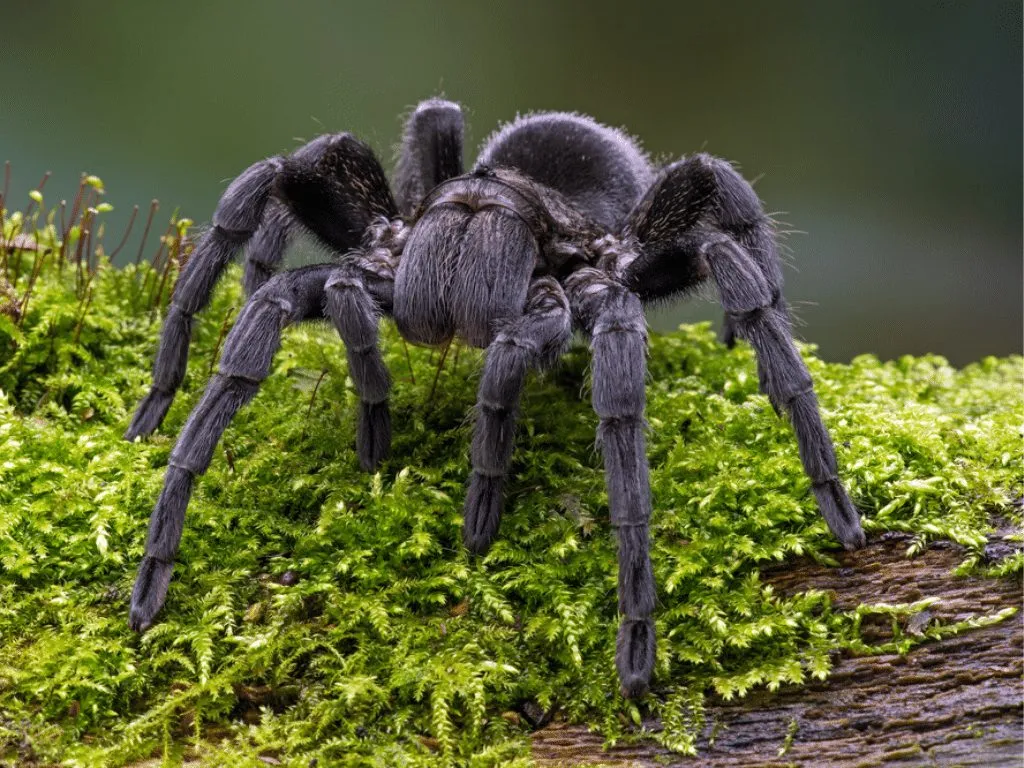
Brazilian Black Tarantulas are a medium-sized tarantula species. Females typically reach a leg span of 5 to 6 inches, while males are often slightly smaller. Their growth rate is relatively slow compared to other tarantula species, which contributes to their long lifespans. The lifespan of these tarantulas is one of the most appealing aspects of their care. Females can live for an impressive 10 to 15 years, sometimes even longer, if provided with optimal care. Males, however, have a much shorter lifespan, usually only living for 3 to 5 years after reaching maturity. This difference in lifespan is a natural characteristic of many tarantula species, with males often dying shortly after mating. The longevity of females makes the Brazilian Black Tarantula a long-term pet commitment, requiring dedicated care for many years.
Temperament and Handling
The Brazilian Black Tarantula is known for its relatively docile temperament, making it a popular choice for beginner tarantula keepers. They are generally not aggressive and rarely display defensive behaviors such as biting or flicking urticating hairs (small, irritating hairs used for defense). However, it’s important to remember that tarantulas are still wild animals and should be handled with caution. Avoid handling your tarantula unless absolutely necessary, as it can cause stress and potentially lead to injury. If handling is required, do so gently and close to the ground, in case the tarantula falls. Always wash your hands thoroughly before and after handling to prevent the transfer of oils or chemicals. Observing your tarantula’s behavior will help you understand its mood and avoid any potential issues. The calm nature of the Brazilian Black Tarantula makes it a rewarding pet, but respect for its needs is important.
Creating the Ideal Brazilian Black Tarantula Habitat
Creating the perfect habitat for your Brazilian Black Tarantula is vital for its health and well-being. The enclosure should mimic their natural environment as closely as possible to reduce stress and encourage natural behaviors. This involves providing the right size enclosure, substrate, temperature, and humidity. Proper setup ensures your tarantula thrives in its environment. This will help create a thriving habitat. The goal is to provide a safe, comfortable space for your tarantula to thrive. It is vital that each element of the habitat is thoughtfully arranged to meet the tarantula’s specific needs.
Enclosure Size and Setup
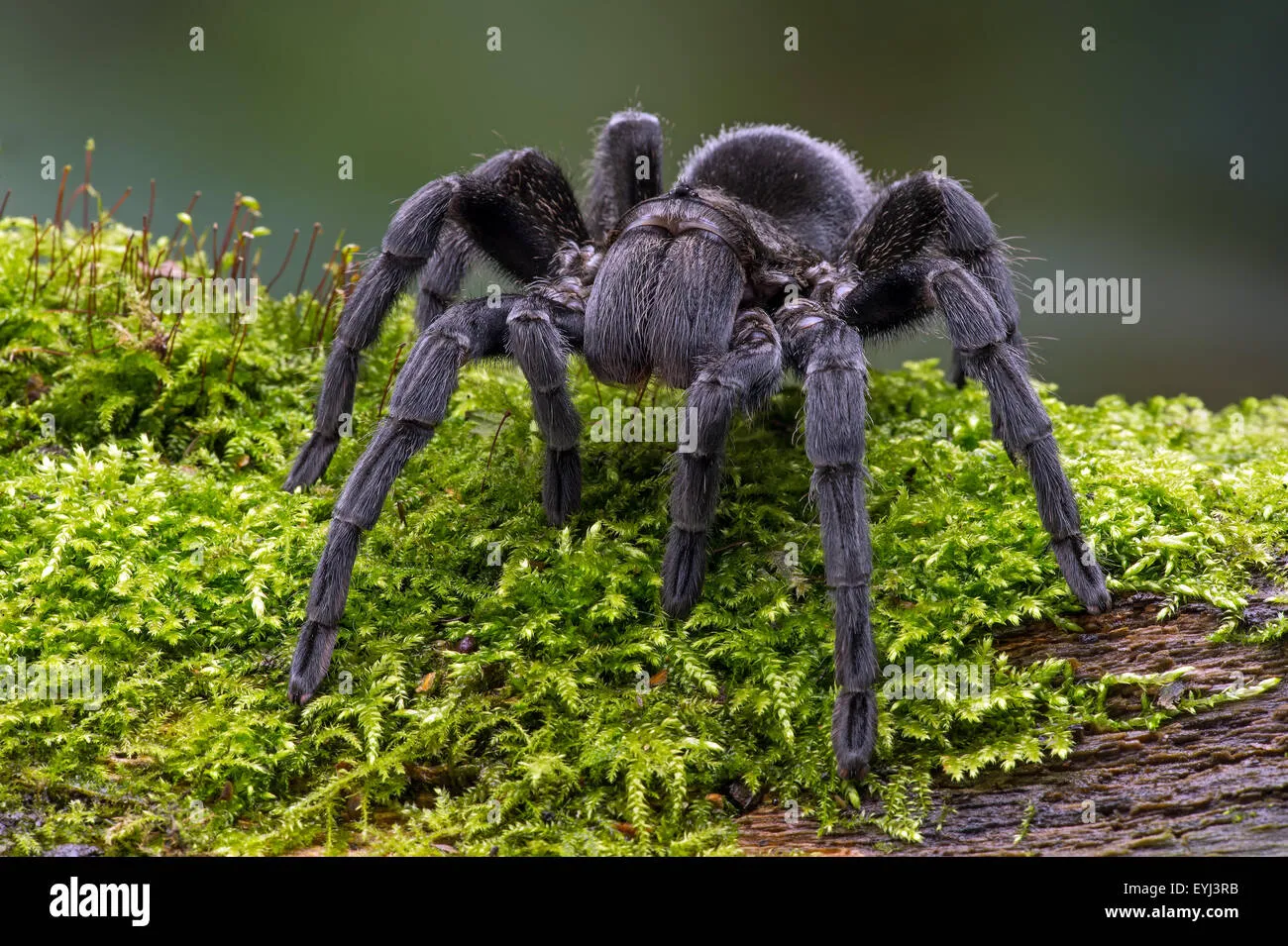
The size of the enclosure is critical for the comfort and safety of your Brazilian Black Tarantula. A juvenile tarantula can be housed in a smaller enclosure, such as a 5-gallon tank or a similar container. As your tarantula grows, you will need to upgrade to a larger enclosure. A fully grown adult Brazilian Black Tarantula should be housed in a 10 to 20-gallon tank. The enclosure should be wider than it is tall since the tarantula is terrestrial and does not climb frequently. The enclosure should have a secure lid to prevent escape and provide adequate ventilation. The setup should also include hiding places, such as a piece of cork bark or a hide made from a hollow log, to provide security. This will help the tarantula feel safe and less stressed, encouraging it to explore and feed regularly. A well-designed enclosure is essential for the tarantula’s physical and psychological well-being.
Substrate and Furnishings
The substrate in your tarantula’s enclosure serves several important purposes. It provides a comfortable surface for the tarantula to walk on, helps to maintain humidity levels, and allows the tarantula to burrow if it chooses. A good substrate choice for a Brazilian Black Tarantula includes a mixture of peat moss, coconut fiber, and a small amount of vermiculite or sphagnum moss. The substrate should be deep enough for the tarantula to burrow if it desires, typically 3 to 5 inches deep. Furnishings are also important. Provide a hide, such as a cork bark or a half-log, for the tarantula to retreat into. Artificial or live plants can also be added to enhance the environment and provide additional hiding places. Always ensure that any decorations are secure and free from sharp edges that could injure your tarantula. A properly furnished enclosure provides both physical and psychological enrichment, contributing to the well-being of your pet.
Temperature and Humidity
Maintaining the correct temperature and humidity levels is essential for the health of your Brazilian Black Tarantula. The ideal temperature range for these tarantulas is between 75°F and 80°F (24°C to 27°C). You can use a heat mat placed on the side or back of the enclosure, connected to a thermostat to maintain a consistent temperature. Avoid placing the heat mat directly under the enclosure, as this could overheat the tarantula. Humidity levels should be kept at around 65% to 75%. You can monitor humidity with a hygrometer. To increase humidity, lightly mist the enclosure with dechlorinated water once or twice a week, depending on the needs of your tarantula and the humidity levels in your area. Ensure that the enclosure has adequate ventilation to prevent mold growth. Providing the correct temperature and humidity will mimic the tarantula’s natural environment, helping it thrive and remain healthy.
Feeding Your Brazilian Black Tarantula
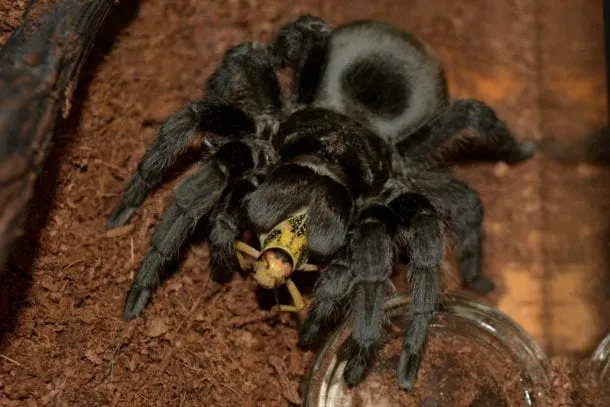
Proper nutrition is crucial for the health and growth of your Brazilian Black Tarantula. The type of food, feeding frequency, and water availability all play important roles in your tarantula’s well-being. Understanding their dietary needs and feeding habits is essential for providing the best possible care. Consistent feeding habits ensure your tarantula is healthy and growing. Regular monitoring of your tarantula’s eating habits will help you identify any potential issues and adjust your feeding schedule accordingly. The following details will help guide you to create a healthy diet.
What to Feed Your Tarantula
Brazilian Black Tarantulas are primarily insectivores, meaning their diet consists mainly of insects. Suitable food items include crickets, mealworms, dubia roaches, and other commercially available feeder insects. It’s important to offer a variety of insects to ensure your tarantula receives a balanced diet. Always ensure that the feeder insects are gut-loaded before feeding them to your tarantula. Gut-loading involves feeding the insects a nutritious diet, such as vegetables, fruits, and commercial insect food, for at least 24 hours before offering them to your tarantula. This enhances the nutritional value of the insects. Avoid feeding wild-caught insects, as they may carry parasites or pesticides. The insects you feed to your tarantula should be of an appropriate size, no larger than the tarantula’s body length. Proper nutrition will ensure your tarantula’s healthy development.
Feeding Frequency and Schedule
The feeding frequency for your Brazilian Black Tarantula will depend on its age and size. Spiderlings (young tarantulas) should be fed more frequently, about twice a week. As the tarantula grows, you can reduce the feeding frequency to once a week or even every other week for adults. Observe your tarantula’s abdomen; if it appears plump and round, it is well-fed. If the abdomen is small, it may be an indication that your tarantula requires more food. Always remove any uneaten food items within 24 hours to prevent the growth of mold or mites in the enclosure. Adjust the feeding schedule as needed based on your tarantula’s eating habits and overall health. Regular monitoring of your tarantula’s eating habits and physical condition helps keep it healthy.
Water and Hydration
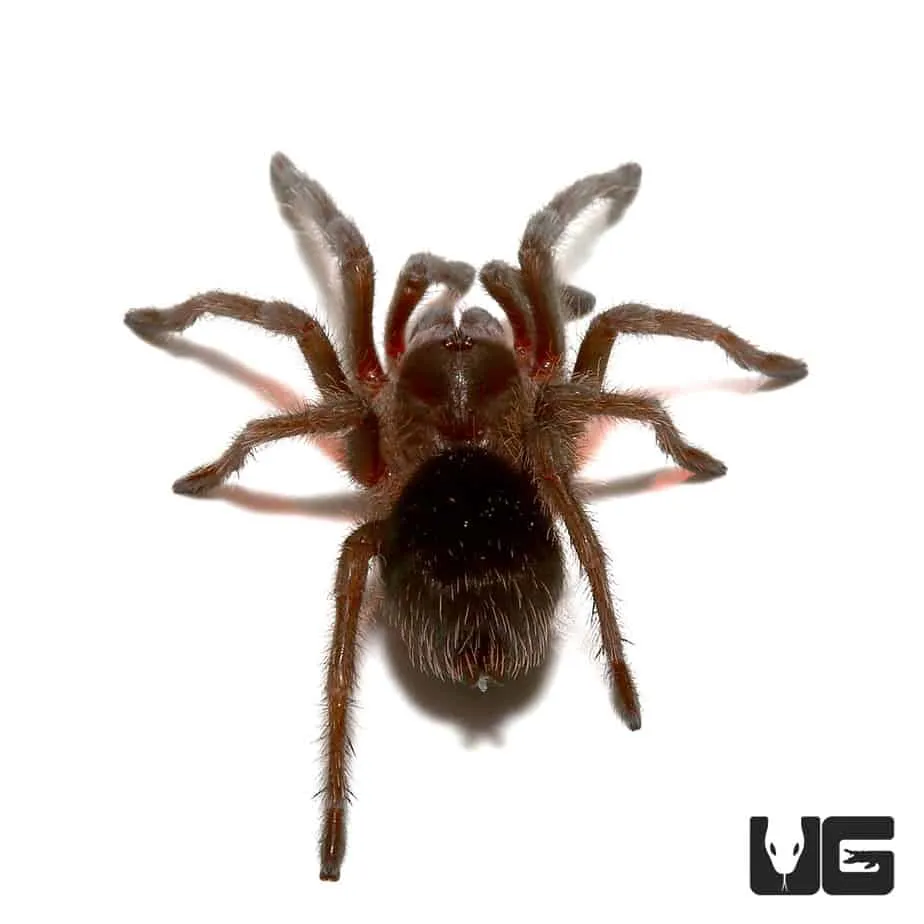
Providing fresh water is essential for your Brazilian Black Tarantula. Always ensure that fresh, clean water is available in a shallow water dish. The water dish should be shallow enough to prevent drowning. Use a water dish or a bottle cap filled with water. Change the water at least twice a week to keep it clean and free of bacteria. You can also mist the enclosure lightly with dechlorinated water, especially during molting, to help maintain humidity levels. Regular access to clean water is crucial for maintaining your tarantula’s hydration and overall health. Regular misting or a water dish provides the necessary hydration to keep your tarantula healthy. Water is essential for a healthy life and prevents dehydration.
Health and Common Issues
While Brazilian Black Tarantulas are generally hardy, they can still experience health issues. Understanding common problems and how to address them is important for responsible pet ownership. Proper care and regular monitoring can help prevent health problems. Early detection and intervention are essential to ensure your tarantula’s well-being. Being proactive will ensure the longevity of your pet.
Moulting Process
Moulting is a natural process where tarantulas shed their exoskeleton to grow. During moulting, your tarantula will typically stop eating and may spend a significant amount of time in a hidden location. You may notice the tarantula lying on its back. Avoid disturbing your tarantula during this vulnerable period. The moulted exoskeleton will look like a complete version of the tarantula. After moulting, the tarantula’s new exoskeleton will be soft. Allow your tarantula a few days to harden before offering food. Make sure the humidity levels are appropriate during this process. Proper care during moulting ensures a smooth transition and healthy growth.
Identifying and Addressing Health Problems
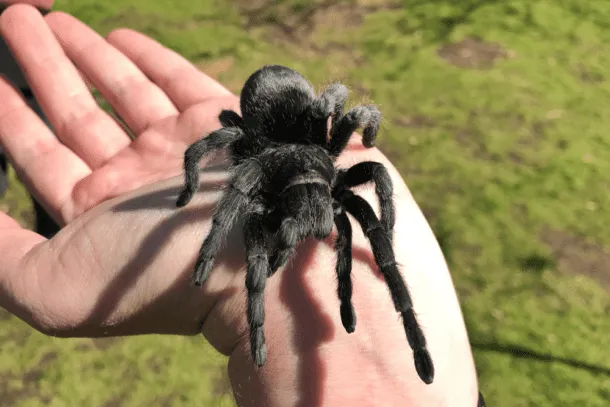
Some common health problems in tarantulas include mites, fungal infections, and injuries. Mites can be identified as small, moving specks on the tarantula or in its enclosure. Fungal infections can occur if humidity levels are too high, resulting in lesions on the tarantula’s body. Injuries can happen if the tarantula falls or is mishandled. If you notice any signs of illness, such as lethargy, loss of appetite, or unusual behavior, consult a veterinarian specializing in exotic animals. Keeping the enclosure clean, maintaining appropriate humidity levels, and providing a balanced diet can help prevent many health problems. Early intervention and proper care are essential for the health of your tarantula. Careful observation of your tarantula’s behavior can help you catch any potential health issues early on.
Breeding a Brazilian Black Tarantula
Breeding Brazilian Black Tarantulas can be a rewarding experience, but it requires careful planning and preparation. Before attempting to breed your tarantulas, make sure you have a thorough understanding of the process and the specific needs of the species. The most important steps are sexing your tarantulas, introducing the male and female, and providing the correct conditions. A proper understanding of the steps ensures success. Be sure you understand the processes involved to prevent any issues during breeding.
Sexing Your Tarantula
Sexing tarantulas is a crucial step in the breeding process. You can determine the sex of a tarantula by examining its shed exoskeleton or the underside of the tarantula. For the shed exoskeleton, look at the epigastric furrow (the groove located between the book lungs). In females, there will be a spermathecae or sperm storage area visible. This is a pouch. For males, the pedipalps (the small appendages near the fangs) will have a modified structure called a ‘boxing glove’ appearance at maturity. Identifying the sex correctly is essential. Accurate sexing will prevent unsuccessful breeding attempts.
Breeding Process
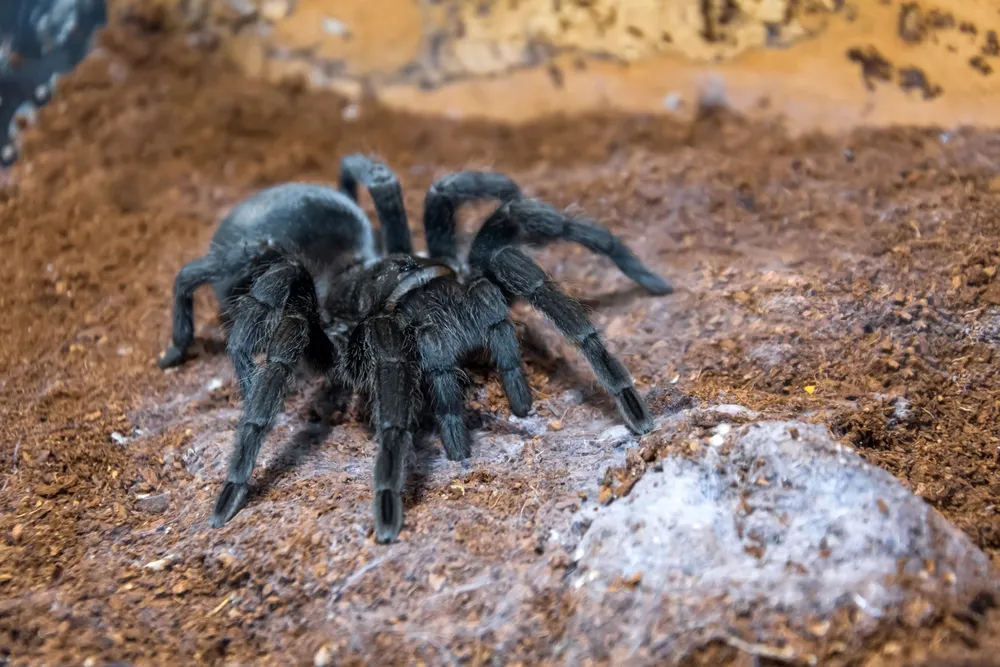
The breeding process typically begins by introducing a mature male to a mature female in the female’s enclosure. It’s important to supervise the introduction closely, as the female may attack the male. If the female is receptive, she will allow the male to mate with her. After mating, the female may lay an egg sac containing hundreds of eggs. Providing appropriate conditions for the egg sac to develop, including the right temperature and humidity, is crucial. Once the spiderlings hatch, they should be separated into individual enclosures to prevent cannibalism. Breeding these tarantulas can be a rewarding experience if you understand the process and have the resources to care for the offspring. Proper care ensures the success of the breeding process.
Why Choose a Brazilian Black Tarantula?
Choosing a Brazilian Black Tarantula as a pet offers several advantages. They have a calm temperament and relatively low maintenance. The ease of care and their longevity make them a great choice for new and experienced arachnid keepers. Their striking appearance and interesting behaviors add to their appeal. Understanding the pros and cons will allow you to make an informed decision. The pros and cons will allow you to determine if this is the right pet for you.
Pros and Cons of Ownership
Pros of owning a Brazilian Black Tarantula include their docile nature, making them easy to handle and observe, their stunning appearance and the long lifespan, giving you years of companionship. They also require less space and are less demanding in terms of time and attention compared to many other pets. Cons include the potential for a bite, although they are not particularly venomous, you might develop an allergic reaction. They are also not interactive pets, and you won’t get the same level of interaction as with other pets. Their care requires specific knowledge of their needs, including temperature, humidity, and feeding requirements. Weighing the pros and cons will help you determine if the Brazilian Black Tarantula is the right pet for you. Carefully consider the responsibilities and potential drawbacks. Understanding the pros and cons is an essential part of responsible pet ownership.
Conclusion
Caring for a Brazilian Black Tarantula can be a fulfilling experience. By providing the right environment, nutrition, and understanding their specific needs, you can enjoy the company of this captivating arachnid for many years. This guide provides a comprehensive overview of how to care for a Brazilian Black Tarantula, from setting up their habitat to handling and feeding them. With proper care, they are an amazing pet. With the information provided, you can enjoy the experience of owning this beautiful species, and ensure the health and well-being of your tarantula. By following the guidelines in this guide, you’ll be well-equipped to provide the best care for your Brazilian Black Tarantula.
